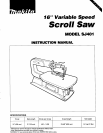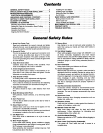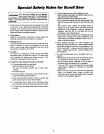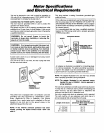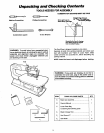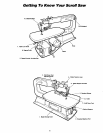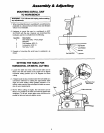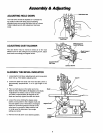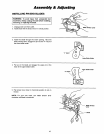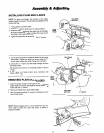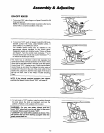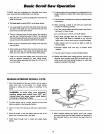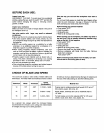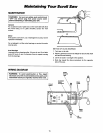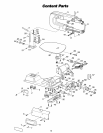
GENERAL SAFETY RULES
......................
.2
SPECIAL SAFETY RULES FOR SCROLL SAW
......
.3
MOTOR SPECIFICATIONS AND
ELECTRICAL REQUIREMENTS
.................
.4
UNPACKING AND CHECKING CONTENTS..
.......
.5
GETTING
TO
KNOW YOUR SCROLL SAW
.........
.6
GLOSSARY
OF
TERMS
.........................
.7
ASSEMBLY
&
ADJUSTING
......................
.8
Mounting Scroll Saw
to
Workbench
................
.8
Setting the Table for Horizontal or Bevel Cutting
......
8
Adjusting Hold down
...........................
.9
Adjusting Dust Blower
..........................
.9
Aligning the Bevel Indicator
.......................
9
Installing Pin End Blade
.........................
10
Removing Plain End Blade
......................
11
On-Off Knob
.................................
12
BASIC SCROLL SAW OPERATION
..............
.13
Making Interior Scroll Cuts
......................
14
Before Each Use
..............................
14
Choice of Blade and Speed
......................
14
MAINTAINING YOUR SCROLL SAW..
............
.15
CONTENT PARTS
............................
.16
TROUBLE SHOOTING
.........................
.19
Installing Plain End Blade
.......................
11
General Safety Rules
1. Know Your Power Tool
Read and understand the owner's manual and labels
affixed
to
the
tool.
Learn its application and limitations as
well as the specific potential hazards peculiar
to
this
tool.
This tool is equipped with an approved 3-conductor cord
and a 3-prong grounding type plug
to
fit the proper
grounding type receptacle. The green conductor in the
cord is the grounding wire. Never connect the green wire
to a live terminal.
Cluttered areas and benches invite accidents. Floor
must not be slippery due
to
wax or sawdust.
Don't use power
tools
in damp or wet locations or ex-
pose them
to
rain. Keep work area well lighted. Provide
adequate surrounding work space.
In working order, and in adjustment and alignment.
Form a habit of checking
to
see that keys and adjusting
wrenches are removed from tool before turning it on.
All visitors should be kept a safe distance from work
area.
With padlocks, master switches, or by removing starter
keys.
9. Don't Force Tool
It
will
do the job better and safer at the rate for which it
was designed.
Serious injury could occur
if
the tool is tipped or
if
the
cutting
tool
is accidentally contacted.
Do not store materials above or near the tool such that it
is necessary to stand on the tool
to
reach them.
11. Use Right Tool
Don't force tools or attachment
to
do a job it was not
designed for.
Do not wear loose clothing, gloves, neckties
or
jewelry
(rings wristwatches)
to
get caught in moving parts. NON-
SLIP footwear is recommended.
Wear protective hair covering
to
contain long hair,
Roll
long sleeves above the elbow.
2. Ground all Tools
3. Keep Work Area Clean
4.
Avoid Dangerous Environment
5.
Keep Guards in Place
6. Remove Adjusting keys and Wrenches
7.
Keep Children Away
8.
Make Workshop Child Proof
10.
Never Stand on Tool
12. Wear Proper Apparel
2
13. Secure Work
Use clamps or a vise
to
hold work when practical.
It's
safer than using your hands and frees both hands
to
operate
tool.
Wear safety goggles (must comply with ANSIZ87.1) at
all times. Everyday eyeglasses only have impact
resistant lenses, they are NOT safety glasses. Also, use
face or dust mask
if
cutting operation is dusty, and ear
protectors (plugs or muffs) during extended periods or
operation.
Keep proper footing and balance at all times.
Before further use of the
tool,
a guard or other part that is
damaged should be carefully checked
to
ensure that it
will operate properly and perform its intended function.
Check for alignment of moving parts, binding of moving
parts, breakage of parts, mounting, and any other
conditions that may affect its operation.
A
guard or any
part that is damaged should be properly repaired or
replaced.
Consult the owner's manual for recommended acces-
sories. Follow the instructions that accompany the ac-
cessories. The use of improper accessories may cause
hazards.
Before servicing; when changing accessories such as
blades, bits, cutter, etc.
Feed work into a blade or cutter against the direction of
rotation of the blade or cutter only.
Keep tools sharp and clean for best and safest
performance. Follow instructions for lubricating and
changing blades, bits, cutters, etc.
Makes sure switch is in "OFF" position before plugging in
power cord.
Turn power
off.
Don't leave tool until it comes
to
a
complete stop.
14. Use Safety Goggles
15. Don't Overreach
16. Check Damaged Parts
17. Use Recommended Accessories
18. Disconnect Tools
19. Direction of Feed
20. Maintain Tools with Care
21. Avoid Accidental Starting
22.
Never Leave Tool Running Unattended



